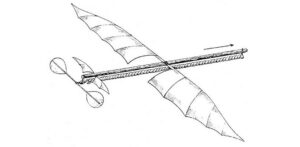twisted rubber

 Until I was listening to the story of the Wright Brothers again, I had never heard of Alphonse Pénaud. Born on May 31, 1850, Pénaud was a 19th-century French pioneer of aviation design and engineering. That seems odd, since the first airplane flight was the Wright Brothers in 1903. Nevertheless, Pénaud was the originator of a type of flight. Before the Wright Brothers took their first flight, they were inspired by Pénaud’s invention of the used of twisted rubber to power a model aircraft called a Planophore, and his 1871 model airplane, was the first aerodynamically stable flying model. He went on to design a full-sized aircraft with many advanced features but was unable to get any support for the project. The twisted rubber design was really more like a modern-day helicopter than a plane. Basically, what Pénaud succeeded in inventing was a toy…a copy of which ended in the hands of the Wright Brothers when their dad brought one home for them from a business trip.
Until I was listening to the story of the Wright Brothers again, I had never heard of Alphonse Pénaud. Born on May 31, 1850, Pénaud was a 19th-century French pioneer of aviation design and engineering. That seems odd, since the first airplane flight was the Wright Brothers in 1903. Nevertheless, Pénaud was the originator of a type of flight. Before the Wright Brothers took their first flight, they were inspired by Pénaud’s invention of the used of twisted rubber to power a model aircraft called a Planophore, and his 1871 model airplane, was the first aerodynamically stable flying model. He went on to design a full-sized aircraft with many advanced features but was unable to get any support for the project. The twisted rubber design was really more like a modern-day helicopter than a plane. Basically, what Pénaud succeeded in inventing was a toy…a copy of which ended in the hands of the Wright Brothers when their dad brought one home for them from a business trip.
Pénaud was born in Paris into a naval family, his father Charles Pénaud being an admiral in the French Navy. Pénaud had hip disease, which required that he walk with the aid of crutches, and also prevented him from being able to attend the Naval School. With that, Pénaud pursued other interests, and at age 20, he began  studying aviation. He joined the newly founded Société Aéronautique de France, and he became vice-president of the Society in 1876. He was a participant in the publication of the journal L’Aéronaute.
studying aviation. He joined the newly founded Société Aéronautique de France, and he became vice-president of the Society in 1876. He was a participant in the publication of the journal L’Aéronaute.
Pénaud excelled in developing model aircraft, and in 1870, made the first of a series of successful model helicopters. While the principle of this was not new, Pénaud upgraded the prior models with the addition of the first use of twisted rubber to power a flying model. During the early years of the development of heavier-than-air flight, many experimenters were to use this method of propulsion for experimental models, including Lawrence Hargrave and AV Roe.
In 1872, he developed a rubber-driven ornithopter. Both the helicopter and the ornithopter enjoyed some success as toys, but this was not what Pénaud wanted to do with his work. In 1873 he started collaborating with an engineer named Paul Gauchot, and produced two designs for full-sized aircraft…the first in 1874 and the second in 1876. The 1876 aircraft was drawn in detail for the purpose of patenting the ideas it incorporated, and had many remarkably advanced features, including electrically operated elevators, a fully enclosed cabin for the pilot, a retractable undercarriage, and the use of a pair of propellers rotating in opposite directions to eliminate the torque reaction caused by a single propeller. Pénaud also participated in lighter than air experimentation, and produced a number of ingenious devices, including a differential barometer to show the rate of ascent or descent. He really was a great innovator, but he just couldn’t raise much interest in his work.

 When Pénaud was unable to obtain any financial backing for his ambitious design. He gave up hope, and on October 22, 1880, at the age of 30, Pénaud committed suicide. Little did he know that twenty short years later, due in part to seeing his work, two preacher’s boys would actually invent a “flying machine” that worked. I think it is incredibly sad that he didn’t live to see that day.
When Pénaud was unable to obtain any financial backing for his ambitious design. He gave up hope, and on October 22, 1880, at the age of 30, Pénaud committed suicide. Little did he know that twenty short years later, due in part to seeing his work, two preacher’s boys would actually invent a “flying machine” that worked. I think it is incredibly sad that he didn’t live to see that day.

